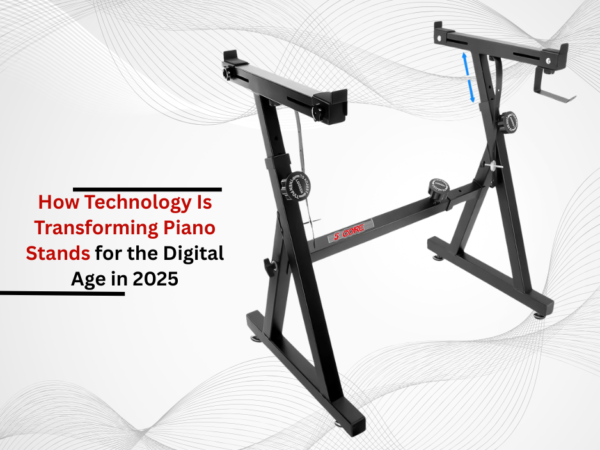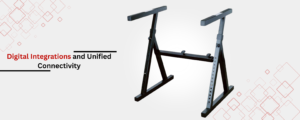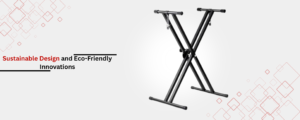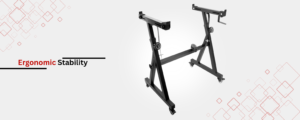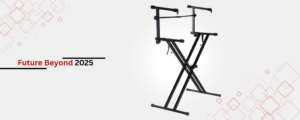In 2025, not much attention has been given to the piano stand with regard to adding technology features. In 2025, these structures will be AI-integrated, constructed with durable materials, and digitally designed to aid in the creative process. In this article, we will describe the self-adjusting stabilizers and energy-independent systems and how these inventions alter the relationship between the musician and the instrument. It is aimed at a new shift towards more adaptability and climate-friendly designs that foster engineering, building, and artistry in a connected global society.
To know more, Read: Keyboard Stands and Benches in 2025: What’s Hot Right Now?
The Development of AI Adaptable Features: Intelligent Adaptation
Self-Correcting Stability Technics:
Modern AI-bolted stabilizers on piano stands offer self-correcting balance. Sensors equipped with a modern digital piano can monitor the height of the floor where it sits and the temperature of the outside, as well as vibrations from neighboring instruments. These sensors have to, for the sake of balance, implement micro-corrections to avoid toppling. In the long run, machine learning systems assessing performances autonomously relying on passive monitoring of stability will apply tilt or rigidity permits termed shelling arpeggiating, slow unfolding, and aggressive keystroke squirting. These proprietary features promise reliable, unmatched performance in challenging, multi-layered resonating spaces.
Life Expectancy and Maintenance Predictive:
Now these cloud-based systems receive and analyze data from IoT devices. Structural Health Monitoring (SHM) identifies stress and fatigue damage using vibration analysis (VBA), which helps in detecting bolt loosening and material fatigue warning. Eco-friendly consumption is optimized by recommending automated maintenance cutoff cycles for parts replacements, thereby reducing waste, enhancing product lifetime and minimizing the environmental footprint. Digital Integrations with Workflow Automation.
Digital Integrations and Workflow Automations
Unified Connectivity Ecosystems:
Modern pianos are equipped with smart features. MIDI controllers and stage lights are DAW peripherals that can be instantly interfaced with USB-C ports located on the charger and the stand alongside Bluetooth 5.3 routers. The stands serve as intelligence hubs because the components of the piano can disable their peripherals after a certain duration. There is self-cleaning cable management as magnets and retractable channels cut clutter without impeding signal pathways.
Applications of Augmented Reality:
Augmented models of AR projection systems allow pianists to follow along using sheet music, chord diagrams, or even mixers overlaid directly into their line of sight. They also can manipulate tempo and effects through gesture-controlled navigation during gameplay. These interfaces transform the learning experience for teachers and students as instant visual feedback within lessons fosters unprecedented interactivity.
Sustainable Design Meets High Performance
Innovative Eco-Sustainable Materials:
Bamboo composites, biomaterials, and reclaimed metals are becoming more common with the advancement of sustainable design. These materials have alloy strength while their carbon footprint is significantly lower. Self-healing plants fix minor scratches by encasing plant-based resins into retaining coats.
Systems With Autonomous Energy:
Kinetic energy harvesters found in the stand joints generate electric power for wireless devices or LED lights. Outdoor models can further supplement power from solar-reactive finishes, making the system self-sustaining for performance venues. Such designs advance the efforts towards sustainability by reducing reliance on non-renewable sources of energy.
Ergonomic Precision for Enhanced Creativity
Biometric Feedback and Customization:
Physiological data enables further refinement of ergonomics. A contact point system with pressure sensitivities that deal with posture, wrist angle, and engagement intensity can propose IP-OP edits through companion applications. Hydraulic systems allow for smooth transitions and free movement between seated and standing warm-up sessions. Various setups for different genres or for numerous collaborative arrangements can be stored in preset memories and recalled later.
Modularity for Evolving Needs:
Upper parts with sockets for tablets and vocal monitors can quickly be put on or off, which is beneficial alongside a variety of musical stands that serve multiple purposes. Synthesizers, along with other devices, make use of collapsible designs tailored for musicians with spatial constraints. Such designs ensure that as technology advances, the requirements of the art will still guarantee the utility and functionality of the stands; after all, they are multifunctional.
The Future Beyond 2025: A Glimpse Ahead
Holographic Integration and Immersive Experiences:
Newer technologies suggest the possibility of having stands with holographic boundaries capable of displaying 3D visualizers or virtual accompaniment. These frameworks might change with the improvisational subtleties of the music, establishing a blend of dependence between the artist and the machine. The use of clear plastics with LED matrices might further eliminate the boundary between an instrument and installation art.
Community-Driven Innovation:
Musical instruments like calliopes or saws have very few, if any, tailored stands for them. Open-source design websites will allow for stands to be created by the very musicians who need them. With the aid of AI, those ideas will be able to be optimized into tools that serve specific subgenres or odd styles. This way, many directions of art can circulate freely and be instantly catered to.
Conclusion
The 2025 piano stands show how even the most basic of technological tools can be transitioned into aiding creativity by using technology. These tools permit eco-conscious construction and digitized systems to interact with one another. Performing and creating are being redefined by these structures. 5 Core, Gleam, K&M, and On Stage are transforming this idea and will one day reach a point where the stand is no longer an opportunistic accessory but a participant within a musical adventure. With the ongoing progression of the digital era, the balance between advancement and creativity will continue to improve and evolve.

